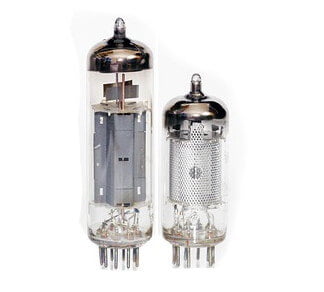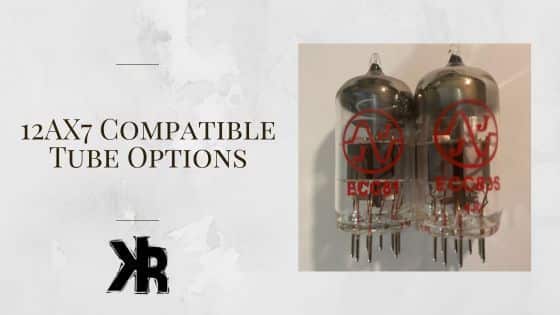Table of Contents
The 12AX7 vacuum tube is a crucial component in various audio applications. This includes guitar amplifiers and high-fidelity audio systems.
Its high gain and specific tonal characteristics have made it a popular choice for those seeking the warmth and depth of analog sound.
As the demand for these tubes continues to grow, finding options that can offer similar or improved performance becomes increasingly important.
This Killer Rig article will focus on 12AX7 compatible tubes, covering the factors that determine compatibility and interchangeability.
We will also provide a comprehensive list of potential replacements. All while discussing the differences in gain, tone, reliability, and price.
Understanding Tube Compatibility
When looking for 12AX7 compatible tubes, it’s essential to consider various factors. Some can affect compatibility and interchangeability.
These factors will ensure that your chosen tube will function correctly with your audio equipment. Without causing damage or undesirable changes in performance.
Factors Affecting Compatibility
- Electrical characteristics: The tube’s electrical properties, such as gain, plate resistance, and amplification factor, should closely match those of the 12AX7. This ensures that the tube will operate correctly within the designed circuit and provide the expected performance.
- Mechanical dimensions: The tube’s physical dimensions, including height, diameter, and pin configuration, must be compatible with the socket and enclosure of your audio equipment. This ensures that the tube can be easily installed and securely connected.
- Heater voltage and current: The tube’s heater requirements (voltage and current) should be compatible with the power supply and transformer of your audio equipment. This prevents potential damage to the tube and your equipment due to overloading or insufficient power.
Interchangeability of Tubes
When it comes to tube interchangeability, there are two main categories:
- Directly replaceable tubes.
- Tubes requiring modification or adaptation.
Directly replaceable tubes can be easily swapped with the 12AX7 without any modifications or adjustments to your equipment.
These tubes share similar electrical characteristics, mechanical dimensions, and heater requirement. This allows for a seamless transition.
On the other hand, some tubes may have comparable electrical characteristics but might require minor modifications to your audio equipment. These modifications can include adjustments to the bias, heater supply, or socket wiring.
These tubes can provide different characteristics or performance improvements. But it’s crucial to ensure that any necessary modifications are performed safely and accurately to avoid damage or suboptimal performance.
Differences in Gain and Tonal Characteristics
Different tubes have varying gain levels. This can impact the overall sound and performance of your audio equipment. Lower-gain tubes, such as the 5751, 12AT7, or 12AU7, tend to provide cleaner and more transparent sound.
This makes them suitable for applications where lower distortion and increased detail are desired.
Tonal characteristics can also vary among compatible tubes. Some tubes may emphasize specific frequencies or produce a warmer, more rounded sound. While others may offer a more linear, balanced response.
It’s essential to consider the desired tonal characteristics when choosing a compatible tube to achieve the ideal sound for your application.
Gain Comparison Chart
| Tube | Gain Rating | Gain as a Percentage of 12AX7 |
|---|---|---|
| 12AX7 / ECC83 | 100 | 100% |
| 7025 | 100 | 100% |
| 5751 | 70 | 70% |
| ECC803S | 100 | 100% |
| 12AT7 / ECC81 | 60 | 60% |
| 12AU7 / ECC82 | 20 | 20% |
| 12AY7 / 6072 | 45 | 45% |
| 12AZ7 | 45 | 45% |
Reliability and Lifespan
The reliability and lifespan of a tube can vary based on the manufacturing process, materials used, and overall build quality. Premium tubes, such as the ECC803S or 7025, typically offer improved reliability and a longer lifespan due to their higher-quality construction.
When considering compatible tubes, it’s important to research the reputation of the tube’s manufacturer. This can be done with user reviews to ensure a reliable and long-lasting choice.
Availability and Price
Some 12AX7-compatible tubes may be more readily available or affordable than others. Factors such as rarity, manufacturing costs, and demand can influence the price and availability of specific tubes.
When selecting one, it’s essential to balance the desired performance and tonal characteristics with your budget. But also the availability of the tube on the market.
List of 12AX7 Compatible Tubes
Some of these tubes can be directly replaced, while others may require minor modifications or adjustments.
Each tube offers specific characteristics, which can influence the overall sound and performance of your audio equipment.

Direct Replacements
- ECC83: This European equivalent of the 12AX7 is virtually identical in terms of electrical characteristics, mechanical dimensions, and heater requirements. It provides a seamless transition and is often used interchangeably in audio equipment.
- 7025: This is a high-quality, low-noise version of the 12AX7 that offers improved performance in terms of reduced microphonics and hum. This tube is an excellent choice for audio equipment that requires low-noise operation.
- 5751: Another directly replaceable tube with slightly lower gain than the 12AX7 (approximately 70% of the 12AX7’s gain). This tube provides a slightly different tonal characteristic, making it suitable for those seeking a cleaner, more transparent sound.
- ECC803S: This is a premium, long-plate version of the ECC83, known for its exceptional sonic qualities and high reliability. This tube offers improved microphonics and stability, making it an excellent choice for demanding audio applications.
Tubes with Similar Characteristics
- 12AT7 / ECC81: The 12AT7 is a lower-gain tube (approximately 60% of the 12AX7’s gain) with slightly different electrical characteristics. This tube may require adjustments to the bias, but it can provide a cleaner, more detailed sound.
- 12AU7 / ECC82: The 12AU7 is another lower-gain tube (20% of the 12AX7’s gain) that offers a more linear and transparent sound. Some modifications to the circuit may be needed to accommodate the different gain and plate resistance.
- 12AY7 / 6072: A lower-gain tube, offering 45% of the 12AX7’s gain, but provides a more dynamic and open sound. It may require minor adjustments to the bias for optimal performance.
- 12AZ7: This is a close relative of the 12AY7, offering a similar gain and tonal characteristics. This tube may also require bias adjustments for optimal performance.
- 12AD7: The 12AD7 is a rare tube with electrical characteristics similar to the 12AX7. This is a low hum and microphonic version made by Sylvania.
When considering these compatible tubes, it’s essential to do some research. It’s important to understand if there are potential modifications and adjustments required for optimal performance.
Consult with a qualified technician if you are unsure about making these changes to your audio equipment.
Conclusion
Finding the right 12AX7-compatible tube for your audio equipment can significantly impact the overall sound and performance.
By understanding the factors that affect compatibility and interchangeability, you can make a better decision when selecting a suitable replacement.
It’s essential to consider differences when comparing compatible tubes. Ensure that you find the ideal option to meet your preferences and your equipment’s requirements.
Don’t be afraid to explore and experiment with different tubes to achieve the desired sound. Each tube offers characteristics that can enhance your audio experience.
Always consult with a qualified technician if you are unsure about making modifications or adjustments to your audio equipment. And remember that proper installation and maintenance are crucial to the longevity and performance of your chosen tube.

